 The Korowai people live in the inaccessible jungle in the southeast of the Indonesian province of Papua, about 150 kilometres inland from the Arafura Sea. They are hunter-gatherers in a small society of traditional family ties who need to share all they have in order to survive. Like the Kombai, the Korowai are known for being great architects of tree houses high up in the tree. Until about 1975 the Korowai had hardly any contact with the outside world. Only the clans living close to a village, have given up their traditional customs and they receive tourists when requested.
The Korowai people live in the inaccessible jungle in the southeast of the Indonesian province of Papua, about 150 kilometres inland from the Arafura Sea. They are hunter-gatherers in a small society of traditional family ties who need to share all they have in order to survive. Like the Kombai, the Korowai are known for being great architects of tree houses high up in the tree. Until about 1975 the Korowai had hardly any contact with the outside world. Only the clans living close to a village, have given up their traditional customs and they receive tourists when requested.
Content:
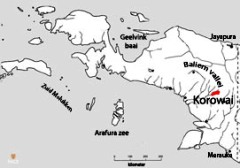 1. Living in villages is a new phenomenon
1. Living in villages is a new phenomenon
2. The last Citak Attack in 1966
3. Missionary expeditions in Korowai area
4. Tree houses as high as 45m
5. Living on what nature provides
6. Dancing at sago grub feasts
7. Girls marry in early teens
8. Contact with the ancestors
9. Conflicts caused by witch craft
10. Links
11. Sources
1. Living in villages is a new phenomenon
The Korowai live on 600 square meters between the Eilanden River, the upper reaches of the Becking River and the Central Plateau of New Guinea in a swampy rain forest of the Upper Digoel Region. 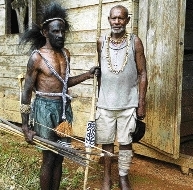 According to estimates, there are between 2500 and 4000 indigenous Korowai people. It is hard to estimate how many there are exactly as increasing numbers of young people shift to villages along the banks of the Becking and Eilanden River. Living in villages or small settlements is a relatively new phenomenon among the Korowia. As is the case in their tree huts, the interior of their homes is divided into two or three rectangular rooms with a fire place in each. Men and women live separately. In 1992 the villages Yaniruma and Manggél received the status of Desa, an official administrative centre. Since the beginning of the 90’s tourists, film teams and makers of documentaries visit the Korowai in the villages and the surrounding areas.
According to estimates, there are between 2500 and 4000 indigenous Korowai people. It is hard to estimate how many there are exactly as increasing numbers of young people shift to villages along the banks of the Becking and Eilanden River. Living in villages or small settlements is a relatively new phenomenon among the Korowia. As is the case in their tree huts, the interior of their homes is divided into two or three rectangular rooms with a fire place in each. Men and women live separately. In 1992 the villages Yaniruma and Manggél received the status of Desa, an official administrative centre. Since the beginning of the 90’s tourists, film teams and makers of documentaries visit the Korowai in the villages and the surrounding areas.
2.The last Citak Attack in 1966
Little is known about the Korowai prior to 1978. However, we do know that they were regularly the victims of headhunting raids by Citak tribes until the 1960’s. The last attack by the Citaks occurred in 1966. A missionary in the upper Digoel region had incidental contact with some of the Korowai during his stay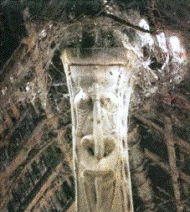 from 1959-1973. After several helicopter flights over the region, missionaries from the Dutch Reformed Church travelled along the Becking River from the Citak region down to the Korowai areas. The first encounter, between the Korowai and the evangelist Johannes Veldhuizen, occurred on 4 October 1978 through the mediation of a Citak guide who was related to one of the Korowai living downstream from the Becking River.
from 1959-1973. After several helicopter flights over the region, missionaries from the Dutch Reformed Church travelled along the Becking River from the Citak region down to the Korowai areas. The first encounter, between the Korowai and the evangelist Johannes Veldhuizen, occurred on 4 October 1978 through the mediation of a Citak guide who was related to one of the Korowai living downstream from the Becking River.
In the Korowai area, Yaniruma was the first settlement which was built on the river mouth at the spot where the Sokom flows into the lower reaches of the Becking River. Around 1980 the Reformed Church mission built a primary school and an outpatient clinic. During the first years of the settlement, Johannes Veldhuizen and Henk Venema arranged various encounters with the Korowai.
3. Missionary expeditions in Korowai area
Between 1978 and 1990, the Korowai living further downstream also came into contact with the outside world, when missionaries from the Reformed Church made a number of expeditions into their territory. From this time on, many young Korowai shifted to settlements set up by the missionaries. They shifted first to Yaniruma and after 1987 also to Manggél and Yafufla, situated respectively 8 and 13 kilometres upstream along the Becking River. In 1989 the village Mabül along the Eilanden River was set up and the village of Sinimborü followed in 2004. Intermittently living in their gardens, the Korowai tend to stay only temporarily in the villages, despite village development programs which have been run by the Indonesian Government since 1985. The Korowai continue to go to their tree houses near their gardens for weeks or months on end to visit family, solve problems, organise a sago grub feast or fertility ritual. Although many Korowai have been introduced to the advantages of the outpatient clinic in Yaniruma, which has been run by an Indonesian Government Agency since mid 1990, many of them still resort to traditional healing methods when they become ill.
upstream along the Becking River. In 1989 the village Mabül along the Eilanden River was set up and the village of Sinimborü followed in 2004. Intermittently living in their gardens, the Korowai tend to stay only temporarily in the villages, despite village development programs which have been run by the Indonesian Government since 1985. The Korowai continue to go to their tree houses near their gardens for weeks or months on end to visit family, solve problems, organise a sago grub feast or fertility ritual. Although many Korowai have been introduced to the advantages of the outpatient clinic in Yaniruma, which has been run by an Indonesian Government Agency since mid 1990, many of them still resort to traditional healing methods when they become ill.
The Korowai are still largely self-sufficient. Apart from certain goods such as stone and (later on) steal axes, salt and similar items, they still produce everything themselves. They used to barter for what they could not grow or gather for themselves, but nowadays they buy these items from small shops (tokos) at the nearest village or mission. Money was first introduced to them by the missionaries. Some Korowai worked at the Missionary stations and others were engaged for the building and maintenance of the air strip at Yaniruma. To start with, they were paid with steal axes, machetes and clothes but later they were paid in rupees. With this money, they can now buy goods in a local shop such as salt, clothes, fish hooks and razor blades. Since 1990, the Korowai have become involved in forestry projects of foreign companies and further down stream, they are being hired as tourist guides and canoe paddlers. Meanwhile, quite a few of the younger generation have not only completed primary school, but have also followed secondary education in Kouh of Boma (Upper Digoel District). There are now even some individuals studying in Jayapura/Abepura.
4.Tree houses as high as 45m
Traditionally, the Korowai lived in isolated conditions, in their own territory near their gardens in settlements of no more than five tree houses. A typical family home is built at about 8 to 12 metres above ground level. But in certain areas upstream, some of the houses are as high as 45 metres. These tree houses protect families not only against swarms of mosquitoes below, but also ward off annoying neighbours and evil spirits.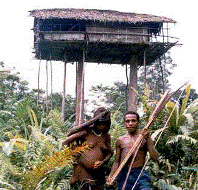
To build a tree house, a sturdy Banyan tree is selected to function as the central pole. The top of the tree is then removed. The floor frame, made of branches, is supported by four to ten other poles.
The bark of the sago palm is used to construct the floor boards and walls. The roof is made of leaves and the frame of the house consists of branches fastened with rattan bindings. A dry tree trunk with notches is hung from the bottom of the tree house in order to get up to the house. This ladder shakes with each step and warns the inhabitants that a visitor is on his way up. Because of their small muscular frame, the Korowai can easily climb up into the trees.
A marriage is usually a suitable occasion for building a new home. Before the residents move permanently into their new tree house, they perform a simple but very evident night time ritual: With a piece of wood they beat on the walls to scare away any evil spirits.
5. Living on what nature provides
The Korowai are able to live off their garden produce and whatever nature provides in their immediate surroundings: sago from the sago palm in their garden, fish from the river and wild pigs from the bush. For fishing and hunting, they use a number of techniques including some based on magic. In times of scarcity, they use magical arrows to call up benevolent spirits.
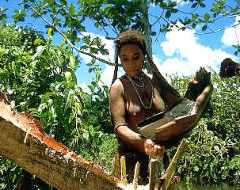 The staple for this Papua population consists of sago and bananas. A single household uses one sago tree per week. After the fibrous trunk is harvested and split by men, the heart of the sago palm, which produces a starchy substance, is washed and kneaded or beaten by the women. Every Korowai family has their own garden near by, in which they cultivate sweet potatoes or bataten, vegetables, as well as tabacco. They collect green vegetables, grass and varieties of flax and wild seasonal fruits, all of which grow in the jungle. Pigs and dogs are the only domesticated animals. The domestic pig has social value and is only eaten during rituals and feasts at special occasions. Dogs are used for hunting and their teeth are regarded as very valuable. Pig hunting is done with bow and arrow. Cassowaries are shot or caught with ropes. For fishing, the Korowai use their bows and arrows, poison and basket-like traps which they place in artificial dams. In the past, crocodiles were also caught for consumption.
The staple for this Papua population consists of sago and bananas. A single household uses one sago tree per week. After the fibrous trunk is harvested and split by men, the heart of the sago palm, which produces a starchy substance, is washed and kneaded or beaten by the women. Every Korowai family has their own garden near by, in which they cultivate sweet potatoes or bataten, vegetables, as well as tabacco. They collect green vegetables, grass and varieties of flax and wild seasonal fruits, all of which grow in the jungle. Pigs and dogs are the only domesticated animals. The domestic pig has social value and is only eaten during rituals and feasts at special occasions. Dogs are used for hunting and their teeth are regarded as very valuable. Pig hunting is done with bow and arrow. Cassowaries are shot or caught with ropes. For fishing, the Korowai use their bows and arrows, poison and basket-like traps which they place in artificial dams. In the past, crocodiles were also caught for consumption.6. Dancing at sago grub feasts
Fertility and prosperity are celebrated during the lengthy sago grub feasts. The larvae of the sago palm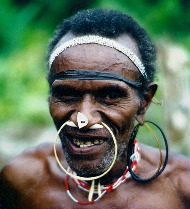 weevil are consumed at these feasts. These larvae (also called sago grubs) thrive in rotting trunks of specially felled palms. Larvae are seen as the ultimate bearers of life. The feasts are attended by numerous guests invited according to rules based on genealogical relationships. Just before the guests leave, the climax of the ritual takes place. This involves removing the barrier around the ‘central and sacred pole’ positioned within an elongated shaped area built especially for the festivities. At the same time a group of Korowai sing songs to accompany the fertility dances performed by young men.
weevil are consumed at these feasts. These larvae (also called sago grubs) thrive in rotting trunks of specially felled palms. Larvae are seen as the ultimate bearers of life. The feasts are attended by numerous guests invited according to rules based on genealogical relationships. Just before the guests leave, the climax of the ritual takes place. This involves removing the barrier around the ‘central and sacred pole’ positioned within an elongated shaped area built especially for the festivities. At the same time a group of Korowai sing songs to accompany the fertility dances performed by young men.
7.Girls marry in early teens
When a person dies, land rights are passed on along the mail line. Similarly, a man ‘inherits’ his sister-in-law when his brother dies. Because men need to pay a dowry, they marry relatively late( at 20 years of age or older). In contrast women marry immediately after their first menstruation.
A household consists of a Korowai man, one or more wives and their unmarried children. If his father has passed away, his mother and her unmarried children will also belong to the household. A household consists of a maximum of 15 individuals and the domestic animals.
Babies are carried in nets warn from the forehead (ainop) and get breast fed for as long as is necessary. The women teach children everything about rules and taboos. A young girl is actively involved in all women’s roles as soon as is possible. Once married, a girl is regarded as an adult. Boys move in with the men in their early teens. A boy learns everything there is to know about a man’s role 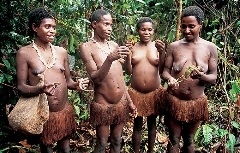 from adult men. At the age of fifteen, he starts taking part in the hunt and any battles to sort out disagreements. During this period a boy is initiated into the special knowledge of the ancestors, the origin of life and the way men exists in the universe. He is not supposed to ask any questions about these matters, because it is the task of an elder to provide him with the necessary information. The Korowai make their children aware of good and evil at an early age . They are also taught about the balance of the cosmos, health, sexuality and traditional knowledge on the invisible world of spirits.
from adult men. At the age of fifteen, he starts taking part in the hunt and any battles to sort out disagreements. During this period a boy is initiated into the special knowledge of the ancestors, the origin of life and the way men exists in the universe. He is not supposed to ask any questions about these matters, because it is the task of an elder to provide him with the necessary information. The Korowai make their children aware of good and evil at an early age . They are also taught about the balance of the cosmos, health, sexuality and traditional knowledge on the invisible world of spirits.
8.Contact with their ancestors
The Korowai believe that the universe is filled with dangerous spiritual beings. The spirits of their ancestors play a special role in this regard. Some older women are said to have knowledge of divination and magical healing. They contact ancestral spirits and are able reverse catastrophic events, detect 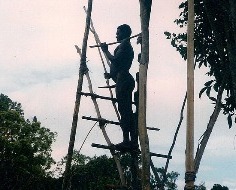 witches or designate where they might be. Some men, known as khakhua (heks), are feared because of their knowledge of magical ways which can cause damage to objects, locations, individuals, and even to whole groups of people. They burn human hair, finger nails, or arrow heads which have been cursed. The Korowai believe that their souls travel to the underworld along ‘the Major Causeway’.
witches or designate where they might be. Some men, known as khakhua (heks), are feared because of their knowledge of magical ways which can cause damage to objects, locations, individuals, and even to whole groups of people. They burn human hair, finger nails, or arrow heads which have been cursed. The Korowai believe that their souls travel to the underworld along ‘the Major Causeway’.
Once they reach their destination, they are welcomed by their ancestors residing in their own territory and they then receive a new body. After a certain period of time, they can be called up to return and reincarnate through a baby about to be born.
They can also reincarnate as animals. The Korowai also believe that the spirit of the deceased will roam around the tree house for some time. The spirit can enter the body of a native lark to help detect witches.
Knowledge of the outside world has been quite limited among the Korowai but this is changing rapidly. In 1997 an Anthropologist and missionary working in the area, said that the Korowai will probably continue their traditional life style for another generation before integrating into ‘modern society’. Like elsewhere in Papua, the young increasingly move to towns and villages and only the elderly remain in the tree house.
(Their traditional way of life is not only threatened by social change but also by the deforestation of the rain forest…..)
9.Conflicts caused by witch craft and adultry
In the past, conflicts between family groups was caused by adultery, theft, murders and issues caused by witchcraft. It is thought that ritual cannibalism occurred under the Korowai as a form of retribution and punishment for the practices of Khakhua. After being killed, the body parts of the Kahkhua were divided among befriended clans and the meat is subsequently eaten. "Revenge is part of our culture, so when the khakhua eats a person, the people eat the khakhua" (Source: Smithsonian Magazine). The so-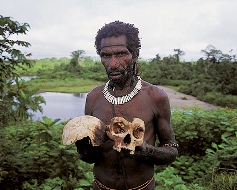 called Khakhua- complex would seem to be the only context in which Cannibalism occurred among the Korowai. It is not clear if it actually happened or if it is merely based on storytelling about revengeful actions. If it is the latter, then it is a case of ‘Historical reconstruction’ ( which may or may not have been done by the Korowai themselves). Whatever the case may be, murder of a member of another clan demands revenge. Even though there is no witchcraft, the relations between the
called Khakhua- complex would seem to be the only context in which Cannibalism occurred among the Korowai. It is not clear if it actually happened or if it is merely based on storytelling about revengeful actions. If it is the latter, then it is a case of ‘Historical reconstruction’ ( which may or may not have been done by the Korowai themselves). Whatever the case may be, murder of a member of another clan demands revenge. Even though there is no witchcraft, the relations between the
groups involved will be dominated by mutual hostility for a long time and it will often include attempts to harm each other by means of magic.
Marriage is also a source of conflict. Maltreatment of a woman is quite common. Adultery committed by a woman is punished by the man who has been offended. He has the right to shoot both the woman and her lover into their thigh. It is not clear if a man can freely commit adultery, but it is likely that he also has to pay for his actions to make up for what he has done. Adultery generally leads to violent arguments which can only be resolved through the exchange of gifts between the families involved. The abduction of women can also cause conflicts, but this is usually resolved by paying a dowry to the woman’s family.
10. Links
- Refer to other theme pages published on this website: Headhunting on the South coast, Eye witness account of a headhunting raid, Pigs and pig feasts in New Guinea, Seventy years of Franciscans in Papua
-‘Sleeping with Canibals’ by Paul Raffaele , in Smithsonian Magazine, September 2006. An article about the author’s encounter with the Korowai.
-An excursion into the Korowai Forest, South-West New Guinea, 2001
- The film Lords of the Garden, 1992
11.Sources
- Gerrit J.van Enk en Lourens de Vries (1997). The Korowai of Irian Jaya: Their Language in Its Cultural Context. New York. Oxford University Press.
- Rupert Stach (2009), Societry of Others. Kinship and mourning in a West Papuan place. Berkeley: University of California Press.
- Rupert Stasch (2001). 'Giving Up Homicide: Korowai Experience of Witches and Police (West-Papua)', Oceania 72 (pp. 33 - 52).
- Gerrit J.van Enk (2002). Korowai. In Encyclopedia of World Cultures - Supplement. New York a.o: Macmillan Reference USA: 183 - 187.
- Rupert Stasch (2003). 'The Semiotics of World-making in Korowai Feast Longhouses', Language & Communication 23 (pp. 359-383).
- Veldhuizen, J. (1982). De Korowai. Een weg in de wildernis. Gedenkboek ter gelegenheid van 25 jaar zending op Irian Jaya door de Groninger kerken (1956-1981), Ed. door Jac. van der Velden et al.., 29-38. Groningen: De Vuurbaak.
- Godschalk, Jan A. (1993). Sela vallei. Een etnografie van een Mek samenleving in de oostelijke Hooglanden, Irian Jaya, Indonesië. Proefschrift. Vrije Universiteit van Amsterdam.
- Rapport, Roy A. (1984). Varkens voor de Voorouders - Ritual in de ecologie van een Nieuw-Guinea People. Een nieuwe, uitgebreide editie. New Haven / London. Yale University Press.
- Venema, H. (1989). Sago Grub Festival. Irian, Bulletin van Irian Jaya, vol. XVII, 38-63. UNCEN. Jayapura (Papua).
- Venema, H. (2006) Hidup Baru. Orang Kristen dalam konteks kebudayaan setempat. Jakarta (Indonesië).
- Versteeg, H. (1983). Zijn stam en taal. Een open plek in het oerwoud, Ed. door Tjerk S. de Vries, 21-25. Groningen: De Vuurbaak.
- Advies en commentaar: Prof. dr. Lourens de Vries, ds. Henk Venema en drs. Sjoerd Jaarsma